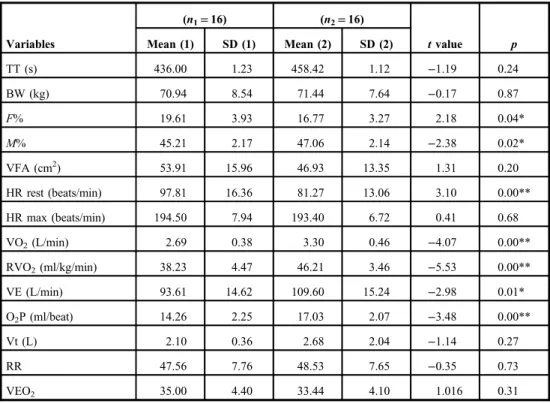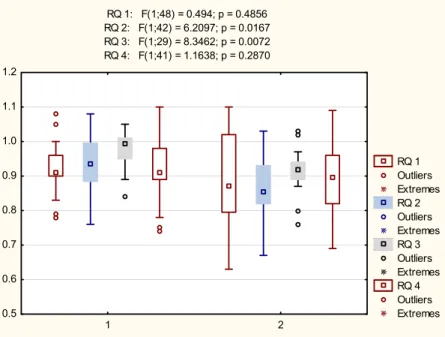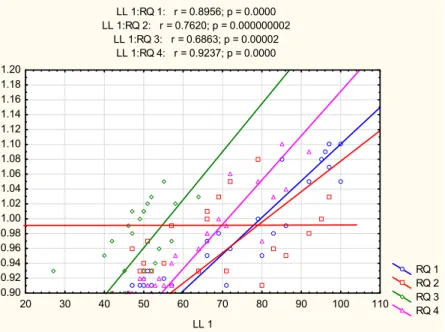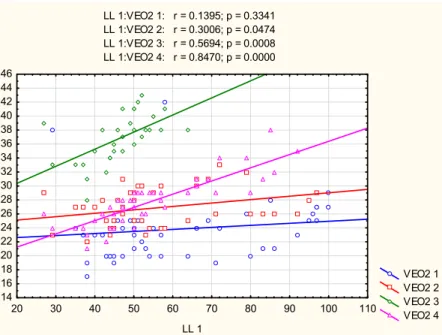Physiology International, Volume 105 (3), pp. 266–275 (2018) DOI: 10.1556/2060.105.2018.2.12
Physiological adaptations to speci fi c endurance training in professional female handball players
SG Gabnai1, L K´osa1, E T ´oth1, N Schulteisz2, J Gangl2, M Othman3, F Ihász1
1Faculty of Pedagogy and Psychology, Department of Sport Sciences, Eötvös Loránd University, Szombathely, Hungary
2Faculty of Health Sciences, Doctoral School of Health Sciences, University of Pécs, Pécs, Hungary
3Branch of Daraa, Third Faculty of Education, Damascus University, Damascus, Syria
Received: June 5, 2017 Accepted: April 23, 2018
Several Hungarian and foreign researchers have already studied the cardiorespiratory parameters of elite handball players. There are only a few studies though, which would separately review the changes in the functions of different organ systems. The aim of this study is to investigate the effect of an intervention (physical activity) on the cardiorespiratory system. In this study, 16 elite female handball players participated, whose body compositions were measured and took two vita maxima tests. During the analysis, each cardiorespiratory parameter was monitored for every 20 s. Between the two examinations, 6 weeks passed and an intervention took place. There was a significant decrease in relative body fat and a significant increase in relative muscle mass. Remarkable positive changes occurred in the values of ventilation, oxygen pulse, and in both absolute and relative aerobic capacities as well. The mean values of the team developed as expected, but the individual changes in body composition and cardiorespiratory parameters are just as important. First, we chose four players, who had the most outstanding changes. Second, we analyzed such parameters, which were expected to show adequate results in terms of the apparatus(es) functioning.
Keywords: cardiovascular and respiratory parameters, maximal workload, intervention, handball players, aerobic capacity
Introduction
Handball is a sport consisting of sets of acyclic movements, where short, maximal intensity efforts are required. So to say, in a handball game, the players are put up for high endurance.
The professional handball match has undergone many changes in the past few decades (1).
The often performed typical technical elements, high-speed runs, jumps, shots from different angles, and collisions together increase the strain on the players, joints, muscles, and the cardiorespiratory system as well. In order to be able to accomplish these tasks, the players must have an optimal physique, body composition (muscle–fat ratio), and sufficient cardiovascular background of the increased muscle mass (4,5). Probably, the most important technical task is the throw affecting the velocity of the thrown ball (6,7,9,11). Hence, the education and training of the technique is essential, because on one hand, deceiving the defenders and the goalkeeper is one possibility to accomplish a successful attack, and on the other hand, this particular action performed for a thousand times will put a lot of strain on the arms, as well as on the shoulders. The velocity of the ball depends not only on the muscle
Corresponding author: Prof. Dr. Ferenc Ihász
Faculty of Pedagogy and Psychology, Department of Sport Sciences, Eötvös Loránd University, Gyor 9012, Fekete István u. 10, Hungary
Phone: +36 3 053 22022; E-mail:ihasz@atif.hu
force, but also on coordination of several body points (biomechanical principles) and on technical parameters (10,12). A full-time player covers close to 5 km during a match, with an average speed of somewhat higher than 5 km/h. High-intensity running takes only a small portion of this distance (approximately 2.5%); however, a single player can perform more than 700 activity changes per match. On average, these players have a relative maximal oxygen uptake of 50 ml/min/kg, and the mean workload during a match requires around 80%
of their VO2. These parameters (especially the rising number of actions and activity changes) suggest short recovery times during a long period of work-time, which might challenge cardiorespiratory fitness and justify the need of a higher level aerobic training (13).
The physical training for handball players includes different types (in terms of load, intensity, and volume) of training, which is likely to increase the cardiorespiratory system parameters.
The goal of this study is to characterize the changes in the cardiorespiratory system during a well-planned and regular training.
Materials and Methods
In this longitudinal study, 16 elite female handball players (age: 23±1.73 years) participated.
All laboratory tests were performed on the same day. Room temperature was between 21 and 22 °C and relative humidity was measured at 50%. Before each test, the subjects had a clinical examination and resting electrocardiogram to check their health status. Their body composi- tions were measured with “InBody 720”(Biospace Co. Inc., Seoul, South Korea) Bioelec- trical Impedance Analyzer. Each player performed a cardiorespiratory exercise test on a treadmill with “Marquette”2000 treadmill (Pittsburgh, PA). VO2maxwas determined using Sensor Medics“Vmax 29C”(Yorba Linda, CA). The heart rate parameters [resting heart rate (HR rest) and maximal pulse (HR max)] were measured by short range radiotelemetry (Polar Sporttester; Polar Electro, Oy, Finland). We calibrated the gas analyzer after each measure- ment. Basic criteria to evaluate VO2max were reaching the plateau in oxygen uptake, respiratory exchange ratio (higher than 1.1), and 90% of age-predicted HR max. Tests were terminated, if subjects achieved maximal oxygen uptake criteria (15) or reported dizziness or muscle fatigue. The step incremental protocol was preceded by a 3-min rest, while the subject was sitting on a chair on the treadmill, followed by a 2-min baseline walking at a speed of 5 km/h at 0° inclination). The incremental exercise was then initiated with a speed of 8 km/h at 3° grades continued inclination. Speed increased every 2 min (1 km/h) and 2° grades inclination. The subjects continued the exercise until reaching volitional fatigue.
During the analysis, we followed the considerations of Frenkl et al. (8), so the specific parameters [HR rest, HR max, minute ventilation (VE), tidal volume (Vt), breath frequency, respiratory quotient (RQ), and ventilatory equivalent for oxygen (VEO2)] were recorded from the beginning of the steady state until the total exhaustion each 20 s. Between the two measurements, a 6-week intervention took place.
Endurance training (E)
The players performed two specific training sessions per day, for five consecutive weeks (separated by one recovery week). The morning training runs were individualized for each player, with difference in their intensities and lengths (endurance running atconstant running
speed of 10:140±8, 12:158±7, and 14 km/h:172±6 beats/min). Training programs followed a typical periodical plan that incorporated progression, prevented overreaching, and used a short tapering period to maximizefinal performance. Thehigh-intensity interval trainingprogram consisted of 6–12 min of intermittent running for 15 s (95% Intermittent Fitness Test) interspersed with 15 s of passive recovery, whereas specific game-based handball trainingprogram consisted of small handball games (2, 24-min-long games in the beginning, which was raised to 3, then 4 games later on as the intervention progressed further.
Recovery time between them varied from 30 s to 4 min) (1–3). As described previously, small group play was organized in 4-a-side teams, excluding goalkeepers. Coaches encouraged players to achieve a high intensity of exercise during these games. Typical handball rules were simplified to avoid game breaks that would unnecessarily reduce exercise intensity.
Strength training (S)
The program was divided into four periods of 6 weeks. During thefirst two periods, the general objective was the development of strength endurance. The exercises included total and segmented movements of upper limbs, trunk, and lower limbs (abdominal strengthening, hip extension with 15 kg, back extensors, half squats with 20 kg, forward alternated arm flexions with 5–10 kg, and forward walking slits with 20 kg). As far as periods 3 and 4 are concerned, particular emphasis was put on the development of explosiveness. The choice of the exercises mainly focused on the muscular chains that are particularly involved in running, i.e., lower limbs [drop jumps from a plinth (0.30–0.60 m), hops, jumps over hurdles (0.50–0.70 m), single leg hops, single leg bonds, and multijumps (22, 23)]. The subjects were trained by short interval circuits (30–30 and 40–20 s). The warm-up lasted about 15–20 min. Recovery between the circuits was set at 2 min, and the total session was about 30 min (warm-up excluded). Exercise intensity was individual, as each subject was asked to perform an optimal number of repetitions per set, inducing fatigue on the one hand and allowing each individual to complete the entire training session on the other. In parallel, throughout the training period, the exercises were made harder by increasing hurdle and plinth heights and jumps and bond length.
During the statistical processing of the data, the Statistica for Windows (version 12.1, StatSoft Inc., Tulsa, OK) was used. The differences between the mean values were analyzed with one sampleT-test (p<0.05). The mean values of the cardiorespiratory parameters were compared using the Kruskal–Wallis method. The cardiovascular and respiratory parameters assigned to identical workload stages were analyzed using F-test.
A comparison to the highest performance player was made in order to add some plasticity to the presentation of some individual changes and adaptations.
Hypotheses
1. A well-planned intervention with sufficient length greatly affects the performance of the cardiorespiratory system and the body composition in a positive way.
2. Studying the performance of the cardiorespiratory system in terms of a team might fade the individual functions and their changes.
3. The qualitative and quantitative changes of the cardiorespiratory system are different in each player; thus, it can be a limiting factor in terms of team efficiency.
Results
The investigators would like to have a comprehensible way of representing the results, so they used well-edited and informative figures.
The relative fat mass (F%;E1−E2=19.61±3.93 vs. 16.77±3.27;p=0.004) significantly decreased and the relative muscle mass (M%; E1−E2=45.21±2.17 vs. 47.05±2.14;
p= 0.002) increased. The resting pulse (HR rest; E1−E2=97.81±16.36 vs. 81.27±13.26;
p=0.000) decreased. The average values of ventilation (VE; E1−E2=93.61±14.61 vs.
109.60±15.23;p=0.005), and oxygen pulse (O2P;E1−E2=14.26±2.25 vs. 17.02±2.07;
p=0.00) has shown significant improvement, as well as absolute and relative VO2 values (TableI). No statistical changes in the efficiency of oxygen utilization (VEO2) were found. The team results changed according to the expectations, but the remarkable deviations inspired the investigators to have a look at the results of a few players individually. Four players who had the most notable differences in their average values have been picked. Besides, Player 1 represents the team’s highest performance, Players 2 and 3 represent the team average, and Player 4 represents the team’s lowest performance; therefore, during the selection, it has been kept in mind that these players should approximately represent every performance range of their team.
Table I. Comparison data of the examined female handball players (E1−E2) (n1=16) (n2=16)
Variables Mean (1) SD (1) Mean (2) SD (2) tvalue p
TT (s) 436.00 1.23 458.42 1.12 −1.19 0.24
BW (kg) 70.94 8.54 71.44 7.64 −0.17 0.87
F% 19.61 3.93 16.77 3.27 2.18 0.04*
M% 45.21 2.17 47.06 2.14 −2.38 0.02*
VFA (cm2) 53.91 15.96 46.93 13.35 1.31 0.20
HR rest (beats/min) 97.81 16.36 81.27 13.06 3.10 0.00**
HR max (beats/min) 194.50 7.94 193.40 6.72 0.41 0.68
VO2(L/min) 2.69 0.38 3.30 0.46 −4.07 0.00**
RVO2(ml/kg/min) 38.23 4.47 46.21 3.46 −5.53 0.00**
VE (L/min) 93.61 14.62 109.60 15.24 −2.98 0.01*
O2P (ml/beat) 14.26 2.25 17.03 2.07 −3.48 0.00**
Vt (L) 2.10 0.36 2.68 2.04 −1.14 0.27
RR 47.56 7.76 48.53 7.65 −0.35 0.73
VEO2 35.00 4.40 33.44 4.10 1.016 0.31
TT: Time spent on the treadmill; BW: body weight;F%: percentage of body fat; M%: percentage of muscle mass;
VFA: visceral fat area; HR rest: resting pulse; HR max: maximal pulse; VO2: absolute aerobe capacity; RVO2: relative aerobe capacity; VE: minute ventilation; O2P: oxygen pulse; Vt: tidal volume; RR: rate of respiratory; VEO2: efficiency of oxygen utilization.
*p<0.05.
**p<0.00
Figure1shows the four chosen players’relative aerobic capacity (RVO2) regarding the two measurements. In case of every player (M1–M4), the averages have significantly risen, as well have the maximal values (M1–M4;p=0.00).
Fig. 1.Changes in the average RVO2values of the individually examined players between the two measurements
Fig. 2.Changes in the average RQ values of the individually examined players between the two measurements
Figure 2 demonstrates the four players’ RQ (metabolic background). In case of Players 2 (M2) and 3 (M3), the change has been significant (M2; p=0.016 and M3;
p=0.007).
Fig. 3.Changes in the average VEO2values of the individually examined players between the two measurements
Fig. 4.Changes in the average PF values of the individually examined players between the two measurements
Figure3shows the four players’efficiency of oxygen utilization (VEO2). Except Player 1 (M1, who anyway has had pleasing results during thefirst measurement), all the players have shown significant improvement (lower value means better efficiency) compared with thefirst measurement. Significant individual differences can be observed compared with the recommended range (shown on the figure), especially in case of Player 3 (M3).
Figure4shows the chosen players’(expiratory) peakflow values. The changes were significant in only two cases (M1; p=0.015 and M4;p=0.000).
The scale of the X-axis in Figs5and6is given by the highest performance player’s performance expressed in percentiles. Figure 5 shows the players’ metabolic background during the exercise. The trend lines show the individual anaerobic breakpoints according to the two measurements’averages (rhombus, triangle, square, and circle). If we observe the patterns of the circles, squares, rhombuses, and triangles, it can be found that all four players have shown significant improvement compared with thefirst measurement.
Figure 6 represents the VEO2 and its changes throughout the exercise. 2–2 players had similarly steep trend lines (M1||M2 and M3||M4). In an optimal case, the workload expressed in percentiles, and the VEO2values does not show a significant correlation, so the efficiency would not deteriorate as the load rises. This has come into existence in only one case: Player 1 (M1).
Fig. 5.Changes in the metabolic background versus the performance values of the highest performance player. The concept of this kind of plotting is based on exhibiting the changes in a somewhat more comprehensive way. The baseline was created upon the player with the highest performance, so that the values we are working with would never exceed 100%, making the comparison less complicated. This way, we have created afixed reference system, in which we could introduce other players’several parameters and their changes throughout different levels of workload. If we were to plot these parameters for each and every player upon their own performance, only the gradients of the trend lines and the position of the plots compared with each other would be different. In these cases, however, these differences are rendered obsolete, since they are pictured in a common reference system (it is like a common denominator), the absolute values have not changed, and on top of that, they can be compared with the
patterns of other players, which expands the possibilities of observations. LL: load level
Discussion
The modern elite handball consists of a series of alternating intensity loads. It has significant aerobic requirements (even in the aerobic zone, mainly submaximal sets) and it crosses the anaerobic threshold on many occasions (13,17,18). Not only it crosses the line, but also several times it requires short stays in the anaerobic zone. The result of a team-level comparison is reassuring for thefirst time, but at least as disturbing at the same time. In the body composition, the abdominal fat surface (visceral fat area) has shown no significant change, nor has depth of ventilation (Vt), respiratory rate, and the efficiency of oxygen utilization (VEO2). The aforementioned merged averages are of course informative, yet likely obscure individual differences. It is even more difficult, to meet these highly demanding requirements as a team, since several players’ optimal performance is needed. Therefore, priority should be given to monitoring and developing the individual performances, because the betterfitness level the players have, the better the team performance will be (14,19). As for the differences between the averages of RVO2values, there was improvement in every case along with VEO2. These verify the quality of cardiovascular adaptation and the success of the intervention. The extremes of the RQ have narrowed, and the aerobic range has extended, which means a shorter anaerobic workload. This presumes a much more econom- ical metabolism and indicates a more effective performance from players (16,20,21). The higher values of RVO2and VEO2indicate the individual development of the four separately examined players. The same can be told about the expiratory peak flow (PF) values.
According to these observations, it seems that the team went through a successful interven- tion. The fact should not be forgotten that different roles have different physiological/
technical/tactical requirements, and this methodological problem urges the need of further analyses and researches.
Fig. 6.Patterns of VEO2changes versus the performance values of the highest performance player. LL: load level
Acknowledgements
The authors would like to thank the management of the Mosonmagyar´ovár Handball Team for their support toward this study and the team’s leaders, for their cooperation with the associates of the SZE Institution of Sport Sciences.
REFERENCES
1. Babraj JA, Vollaard NB, Keast C, Guppy FM, Cottrell G, Timmons JA: Extremely short duration high intensity interval training substantially improves insulin action in young healthy males. BMC Endocr. Disord. 9, 3 (2009)
2. Bajpeyi S, Tanner CJ, Slentz CA, Duscha BD, McCartney JS, Hickner RC, Kraus WE, Houmard JA: Effect of exercise intensity and volume on persistence of insulin sensitivity during training cessation. J. Appl. Physiol.
106, 1079–1085 (2009)
3. Bangsbo J: The physiology of soccer–with special references to intense intermittent exercise. Acta Physiol.
Scand. Suppl. 619, 1–155 (1994)
4. Chaouachi A, Brughelli M, Levin G, Boudhina NB, Cronin J, Chamari K: Anthropometric, physiological and performance characteristics of elite team-handball players. J. Sports Sci. 27, 151–157 (2009)
5. Chelly MS, Hermassi S, Shephard RJ: Relationships between power and strength of the upper and lower limb muscles and throwing velocity in male handball players. J. Strength Cond. Res. 24, 1480–1487 (2010) 6. Davidsen PK, Gallagher IJ, Hartman JW, Tarnopolsky MA, Dela F, Helge JW, Timmons JA, Phillips SM: High
responders to resistance exercise training demonstrate differential regulation of skeletal muscle microRNA expression. J. Appl. Physiol. 110, 309–317 (2011)
7. Fleck SJ, Smith S, Craib M, Denaham T, Snow RE, Mitchell ML: Upper extremity isokinetic torque and throwing velocity in team handball. J. Appl. Sport Sci. Res. 6, 120–124 (1992)
8. Frenkl R, Mészáros J, Petrekanits M, Farkas A, Mohácsi J, Szab´o T: Aerobic power and anthropometric characteristics of Hungarian Schoolboys. Human Evol. 13, 97–105 (1998)
9. Gibala MJ, Little JP, van Essen M, Wilkin GP, Burgomaster KA, Safdar A, Raha S, Tarnopolsky MA: Short- term sprint interval versus traditional endurance training: similar initial adaptations in human skeletal muscle and exercise performance. J. Physiol. 575, 901–911 (2006)
10. Gorostiaga EM, Granados C, Ibanez J, Gonzalez-Badillo JJ, Izquierdo M: Effects of an entire season on physical fitness changes in elite male handball players. Med. Sci. Sports Exerc. 38, 357–366 (2006)
11. Gorostiaga EM, Granados C, Ibanez J, Izquierdo M: Differences in physicalfitness and throwing velocity among elite and amateur male handball players. Int. J. Sports Med. 26, 225–232 (2005)
12. Granados C, Izquierdo M, Ibanez J, Bonnabau H, Gorostiaga EM: Differences in physicalfitness and throwing velocity among elite and amateur female handball players. Int. J. Sports Med. 28, 860–867 (2007) 13. Hoff M, Almasbakk B: The effects of maximum strength training on throwing velocity and muscle strength in
female team-handball players. J. Strength Cond. Res. 9, 255–258 (1995)
14. Hollowell RP, Willis LH, Slentz CA, Topping JD, Bhakpar M, Kraus WE: Effects of exercise training amount on physical activity energy expenditure. Med. Sci. Sports Exerc. 41, 1640–1644 (2009)
15. Howley ET, Basett DR Jr, Welch HG: Criteria for maximal oxygen uptake: review and commentary. Med. Sci.
Sports Exerc. 9, 1292–1301 (1995)
16. Jacobs I, Westlin N, Rasmusson M, Houghton B: Muscle glycogen and diet in elite players. Eur. J. Appl.
Physiol. 48, 297–302 (1982)
17. Michalsik LB, Aagaard P, Madsen K (2011): Match performance and physiological capacity of male elite team handball players. In: European Handball Federation Scientific Conference 2011 –Science and Analytical Expertise in Handball. Proceedings of the First International Conference on Science in Handball, European Handball Federation, Vienna, Austria, pp. 168–173. Available at: https://www.researchgate.net/publication/
284190273_Match_Performance_and_Physiological_Capacity_of_Female_Elite_Team_Handball_Players 18. Mikkelsen F, Olesen MN (1976): Handball 82–84 (Traening af skudstyrken). Trygg-Hansa, Stockholm,
pp. 40–70. Available at:http://www2.unavarra.es/gesadj/depCSalud/mikel_izquierdo/granadosIJSM2007.pdf 19. Moncef C, Said M, Olfa N, Dagbaji G: Influence of morphological characteristics on physical and physiological
performances of Tunisian elite male handball players. Asian J. Sports Med. 3, 74–80 (2012)
20. Rakobowchuk M, Tanguay S, Burgomaster KA, Howarth KR, Gibala MJ, Macdonald MJ: Sprint interval and traditional endurance training induce similar improvements in peripheral arterial stiffness andflow mediated dilation in healthy humans. Am. J. Physiol. Regul. Integr. Comp. Physiol. 295, R236–R242 (2008)
21. Skoufas D, Kotzamanidis C, Hatzikotoylas K, Bebetsos G, Patikas D: The relationship between the anthropo- metric variables and the throwing performance in handball. J. Hum. Mov. Sci. 45, 469–484 (2003) 22. Van den Tillaar R: Effect of different training programs on the velocity of overarm throwing: a brief review.
J. Strength Cond. Res. 18, 388–396 (2004)
23. Wallace MB, Cardinale M: Conditioning for team handball. Strength Cond. J. 19, 7–12 (1997)




